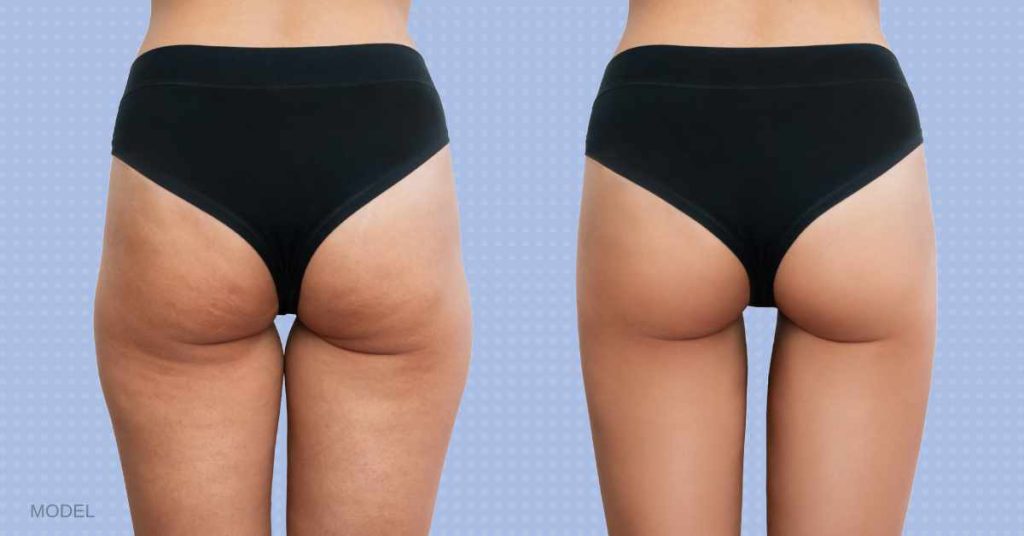Did you know that men do not have cellulite?! WHAAAT? How is that possible? Just believe me, it is true. So what are we women to do about it? In this blog, I will discuss the cause of cellulite and the current treatment options to help lessen its appearance. While there is no “cure-all” yet, there are some promising treatment options that can help us!
I often see patients in my Columbus, Ohio, plastic surgery practice who have cellulite on their legs, bottoms, and even arms! They sometimes are quite lean and other times have a few extra pounds, but their concern is the dimpling on their flanks, legs, buttocks, and even upper arms.
What Causes Cellulite?
What is this situation that causes the skin to be tethered or dimpled? Why do some of us have cellulite?
In simple terms, cellulite is a connection between the skin and the underlying muscle that tethers or holds that skin, causing the dimpling. These fibrous connective tissue bands cause the appearance of cellulite. And the crazy part is that some people have it, and some don’t—but men never have it! Why? Ask the God of the Universe because I do not know!
And let’s not forget our enemy—GRAVITY.
First, I want to be sure all of you know that when you are lying flat—on your back or stomach—there is NO cellulite visible! WHAAAT, you say. Yep, this is God’s special sense of humor because when we lay on our stomachs or backs there is no dimpling—no cellulite. And side note: Our faces look really good when we are horizontal on our backs! Not to mention how great our abdomens look in this position! But back to cellulite … we are obviously standing up and looking in the mirror to see the dimples, and we want them gone.
So accepting these facts, we can move on to the treatment options that will help lessen the appearance of cellulite.
Conventional Cellulite Treatments
When I started my practice 26 years ago, we did not have much to offer the patients who came in with cellulite complaints. Sometimes I would do traditional liposuction but also use a specialized instrument called a “pickle fork” to cut the fibrous bands. The pickle fork cannula had a V-shaped point at the end, and it could be used to sever the fibrous attachments, allowing the skin to move and lessening the dimpled appearance. This was the “answer” for mild cases and localized or minimal dimpling. The challenge was the patient who had the dimpling across their entire buttocks or thigh. For these cases, I usually had to say that there was going to be an improvement, but we could not promise the result would be as smooth as we wanted.
New Cellulite Treatment Options
Over the last 10 to 20 years a number of treatment options have come to the market, and they all seem to have the same conclusion—yep, it will be better, but the worse the cellulite, the less likely it is that the treatment will yield the desired result. In other words, if you have a pretty good curvy shape and there are just a few dimples, then the result will be better than the other patient who has dimples from the hip to the knee.
Liposuction & the Pickle Fork
Liposuction with the addition of the pickle fork is still one option. If you are considering liposuction, be sure to pick a skilled board-certified plastic surgeon. I offer some tips for finding the right surgeon for you in a related blog post.
But liposuction is only a good option for those patients who actually want liposuction. What about the patients that don’t need or want lipo and just want some of the dimples diminished? A few products have come to the market to address this exact scenario.
Cellfina®
One of the first such devices was Cellfina. This is a product to help the plastic surgeon go under the skin and cut the fibrous attachments in a simple and standardized way. It is a disk-shaped device, and the area under it is cut to release the banding.
Avéli™
Another device that has recently been developed to target cellulite is called Avéli. This device reminds me of a crochet hook or latch hook for making pillows … except it has a sharp tip and a light that helps the surgeon guide the device to the precisely correct area. Once there, the sharp cutting part is deployed to sever the band.
The good news about these devices is that they are considered minimally invasive and just a small area needs to be numbed up first.
As these and other devices are developed and refined, the quest to really end the appearance of cellulite remains an elusive goal. For patients who are interested in diminishing their cellulite, we welcome them to contact the A-team at Aesthetica, and we will discuss the options. Feel free to give us a call at (614) 569-2649 or use our online form to request a consultation.


Leave a Reply